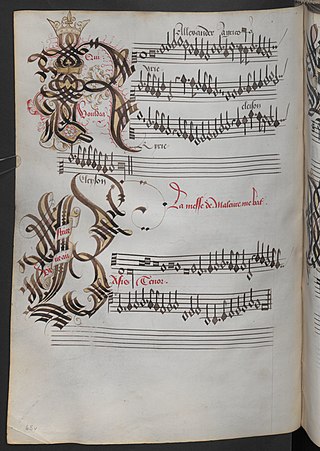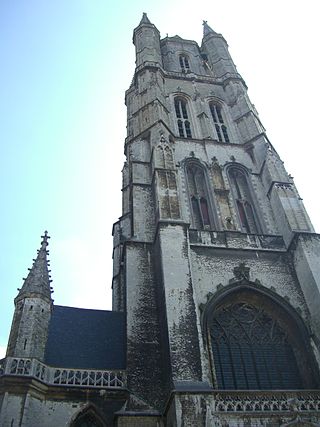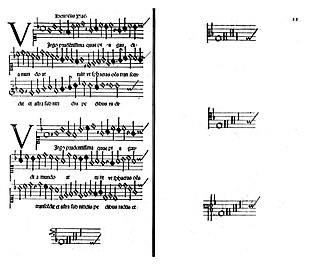
Josquin Lebloitte dit des Prez was a composer of High Renaissance music, who is variously described as French or Franco-Flemish. Considered one of the greatest composers of the Renaissance, he was a central figure of the Franco-Flemish School and had a profound influence on the music of 16th-century Europe. Building on the work of his predecessors Guillaume Du Fay and Johannes Ockeghem, he developed a complex style of expressive—and often imitative—movement between independent voices (polyphony) which informs much of his work. He further emphasized the relationship between text and music, and departed from the early Renaissance tendency towards lengthy melismatic lines on a single syllable, preferring to use shorter, repeated motifs between voices. Josquin was a singer, and his compositions are mainly vocal. They include masses, motets and secular chansons.

Heinrich Isaac was a Netherlandish Renaissance composer of south Netherlandish origin. He wrote masses, motets, songs, and instrumental music. A significant contemporary of Josquin des Prez, Isaac influenced the development of music in Germany. Several variants exist of his name: Ysaac, Ysaak, Henricus, Arrigo d'Ugo, and Arrigo il Tedesco among them.
Nicolas Gombert was a Franco-Flemish composer of the Renaissance. He was one of the most famous and influential composers between Josquin des Prez and Palestrina, and best represents the fully developed, complex polyphonic style of this period in music history.

Jacob Obrecht was a Flemish composer of masses, motets and songs. He was the most famous composer of masses in Europe of the late 15th century and was only eclipsed after his death by Josquin des Prez.

Alexander Agricola was a Netherlandish composer of the Renaissance writing in the Franco-Flemish style. A prominent member of the Grande chapelle, the Habsburg musical establishment, he was a renowned composer in the years around 1500, and his music was widely distributed throughout Europe. He composed music in all of the important sacred and secular styles of the time.

Pierre de la Rue was a Franco-Flemish composer and singer of the Renaissance. His name also appears as Piersson or variants of Pierchon and his toponymic, when present, as various forms of de Platea, de Robore, or de Vico. A member of the same generation as Josquin des Prez, and a long associate of the Habsburg-Burgundian musical chapel, he ranks with Agricola, Brumel, Compère, Isaac, Obrecht, and Weerbeke as one of the most famous and influential composers in the Netherlands polyphonic style in the decades around 1500.

Kryštof Harant of Polžice and Bezdružice was a Czech nobleman, traveler, humanist, soldier, writer and composer. He joined the Protestant Bohemian Revolt in the Lands of the Bohemian Crown against the House of Habsburg that led to Thirty Years' War. Following the victory of Catholic forces in the Battle of White Mountain, Harant was executed in the mass Old Town Square execution by the Habsburgs.

Paul Hofhaimer was an Austrian organist and composer. He was particularly gifted at improvisation, and was regarded as the finest organist of his age by many writers, including Vadian and Paracelsus; in addition he was one of only two German-speaking composers of the time who had a reputation in Europe outside of German-speaking countries. He is grouped among the composers known as the Colorists.
Soggetto cavato is an innovative technique of Renaissance composer Josquin des Prez that was later named by the theorist Zarlino in 1558 in his Le istitutioni harmoniche as soggetto cavato dalle vocali di queste parole, or literally, a subject 'carved out of the vowels from these words.' It is an early example of a musical cryptogram.

A paraphrase mass is a musical setting of the Ordinary of the Mass that uses as its basis an elaborated version of a cantus firmus, typically chosen from plainsong or some other sacred source. It was a common means of mass composition from the late 15th century until the end of the 16th century, during the Renaissance period in music history, and was most frequently used by composers in the parts of western Europe which remained under the direct control of the Roman Catholic Church. It is distinguished from the other types of mass composition, including cyclic mass, parody, canon, soggetto cavato, free composition, and mixtures of these techniques.
The decade of the 1510s in music involved some significant events.
The Choralis Constantinus is a collection of over 375 Gregorian chant-based polyphonic motets for the proper of the mass composed by Heinrich Isaac and his pupil Ludwig Senfl. The genesis of the collection is a commission by the Constance Cathedral for Isaac, at that time the official court composer for the Holy Roman Emperor Maximilian I, to compose a set of motets for the special holy days celebrated in the diocese of Constance. Isaac was in Constance at the time with the Imperial court as Maximilian had called a meeting of the German nobility (Reichstag) there. The music was delivered to the Constance Cathedral in late 1508 and early 1509.

Jheronimus Vinders was a Franco-Flemish composer of the Renaissance, active at Ghent. He was a minor member of the generation after Josquin des Prez, and he also composed a notable lament on the more famous composer's death.
Jacob Regnart was a Flemish Renaissance composer. He spent most of his career in Austria and Bohemia, where he wrote both sacred and secular music.

Stimmwerck was a male classical music vocal quartet ensemble specializing in the rediscovery and reproduction of the music of little known renaissance composers of the German-speaking world.
Manfred Cordes is a German conductor of early music, musicologist and teacher. He is professor at the Hochschule für Künste Bremen and was its rector from 2007 to 2012.
Mattheus Le Maistre or Matthaeus Le Maistre was a Flemish Renaissance choirmaster and composer who is best known for his time in Dresden. His music was superior but in no way progressive, influential in both Counter-Reformation and Lutheran courts.
Ludwig Daser was a German renaissance composer and choirmaster. His career is marked by the Reformation and Counter-Reformation struggles of his time. A noted composer in his day, Daser has been largely overshadowed by Orlande de Lassus, who replaced him in Munich.

The Liber selectarum cantionum is a collection of motets which was printed in Augsburg in the workshop of Sigmund Grimm and Markus Wirsung in 1520. Its full title is Liber selectarum cantionum quas vulgo mutetas appellant sex quinque et quatuor vocum which means translated into English: "Book of selected songs, commonly called motets, for six, five, and four voices". The print is dedicated to the cardinal and prince-archbishop of Salzburg Matthäus Lang von Wellenburg. The epilogue was penned by the humanist Konrad Peutinger. Ludwig Senfl selected the compositions, prepared them for printing, and possibly also assisted as a proofreader.

Virgo prudentissima is a six-voice motet (SSAATB), dedicated to the Virgin Mary and composed by Heinrich Isaac in 1507. The motet describes the Assumption of Mary, calling on her and the nine orders of angels to protect Emperor Maximilian I and the Holy Roman Empire. The lyricist was Georg von Slatkonia.












